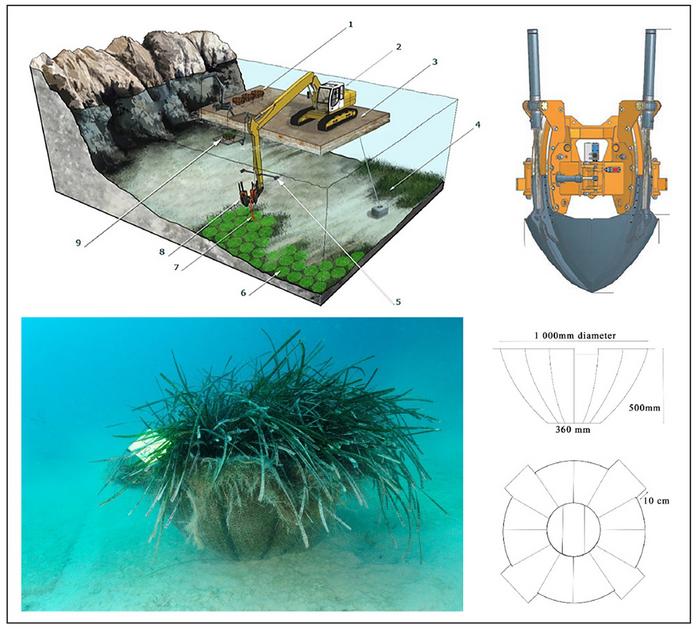A groundbreaking study in Monaco has shattered the traditional notion that seagrass meadows are non-transplantable. Over the course of eight years, researchers successfully transplanted 384 square meters of Posidonia oceanica, a vital underwater plant species crucial to the Mediterranean ecosystem. This pioneering effort, conducted under the auspices of Andromède Océanologie and in collaboration with the University of Liège, marks a significant milestone in ecological restoration and presents an innovative strategy for mitigating the environmental impacts of coastal development.
As part of the Mareterra district construction project, extensive marine works resulted in the destruction of several hectares of Posidonia oceanica meadows. Recognizing the ecological value of these habitats, the involved teams embarked on a large-scale transplantation operation to preserve the remaining seagrass. The project aimed not only to relocate the seagrass but also to validate a novel technique called "clod" transplantation, which protects the plant’s roots and the surrounding substrate, thereby enhancing survival chances.
The transplantation effort began in 2017 when selected seagrass clumps were carefully relocated to the Larvotto marine reserve. This method aimed to preserve the integrity of the root system, which is crucial for the resilience of the plant. Remarkably, after three years post-transplantation, both the relocated and the natural seagrass meadows began to flower, indicating that the transplanted individuals had adapted well to their new environment. This early success bolstered hopes for a recovery trajectory that would transcend mere survival.
With rigorous monitoring and assessment conducted over the eight-year period, researchers observed that the transplanted meadows showed remarkable resilience despite the ongoing construction activities nearby. Health indicators such as shoot density and biomass began to mirror those of the neighboring natural meadows, demonstrating a remarkable recovery and integration into the local ecosystem. This finding reflects a higher level of ecological adaptability than previously assumed, providing compelling evidence that large-scale transplantation is now a practical option for restoration.
By 2024, the newly established meadow had expanded, exceeding the area that was initially transplanted by over 25%. This growth not only highlights the viability of the transplantation technique but also showcases the ecological function of the seagrass. These results contribute to a growing body of evidence suggesting that active ecological restoration, through methods like transplantation, is a necessary avenue for addressing the biodiversity crisis exacerbated by urban development.
Sylvie Gobert, an oceanologist at the University of Liège and a key figure in the study, emphasized the importance of this experiment in the context of ecological preservation. "For the first time, we can confidently claim that transplantation is a viable alternative for mitigating environmental impacts resulting from coastal infrastructure projects," she noted. This perspective reframes the conversation around marine conservation, offering a hopeful outlook for similar projects in the future.
Historically, the destruction of seagrass habitats has been viewed as an irreparable loss, with compensatory measures limited predominantly to constructing artificial reefs that fail to address the root ecological issues. The findings from this study could revolutionize this approach, transitioning focus toward living, sustainable solutions that leverage the natural resilience of seagrass ecosystems.
The University of Liège has long been a leader in marine studies, particularly involving Posidonia oceanica and its crucial role in coastal ecosystems. Their research efforts, spanning back to the 1970s at the STARESO underwater research station in Corsica, have provided invaluable insights into the dynamics of seagrass meadows. This extensive background allowed the researchers to design a rigorous methodology ensuring the successful implementation of transplantation protocols.
As the implications of this study ripple outwards, it raises questions about how existing conservation policies are formulated. "By incorporating seagrass transplantation as a permissible mitigation measure in future coastal development projects, we can significantly lessen the environmental toll while safeguarding vital habitats," stated Gobert. This sentiment underscores the urgent need for evolved regulatory frameworks that prioritize sustainable practices in marine environments.
The broader ecological significance of Posidonia oceanica cannot be understated. Besides providing essential habitat for diverse marine life, these meadows also play a critical role in carbon sequestration, helping to mitigate climate change impacts. Their protection and restoration, therefore, cannot be merely an afterthought but should be integral to any coastal development agenda.
This momentous study heralds a new era of conservation efforts where transplantation may no longer be seen as an experimental endeavor but as a standard practice in managing marine ecosystems. The success in Monaco could encourage similar initiatives across the Mediterranean and beyond, where seabed habitats are under threat from increasing anthropogenic pressures.
In conclusion, this landmark achievement asserts itself as a testament to human ingenuity and ecological resilience. As the quest for better environmental stewardship continues, the findings from this extensive research exemplify a path forward that intertwines developmental progress with the essential goal of protecting our planet’s precious marine ecosystems. Through the integration of such innovative practices, we can foster a future where development and conservation coexist, ultimately ensuring the preservation of biodiversity for generations to come.
Subject of Research: Transplantation of Posidonia oceanica seagrass
Article Title: Groundbreaking Transplantation of Seagrass Shatters Convention
News Publication Date: October 23, 2023
Web References: Andromède Océanologie, University of Liège, STARESO
References: Gobert, S. et al. (2024). Environmental Challenges. DOI: 10.1016/j.envc.2025.101087
Image Credits: Andromède Océanologie
Keywords: seagrass, transplantation, Posidonia oceanica, marine conservation, ecological restoration, biodiversity, coastal development.




